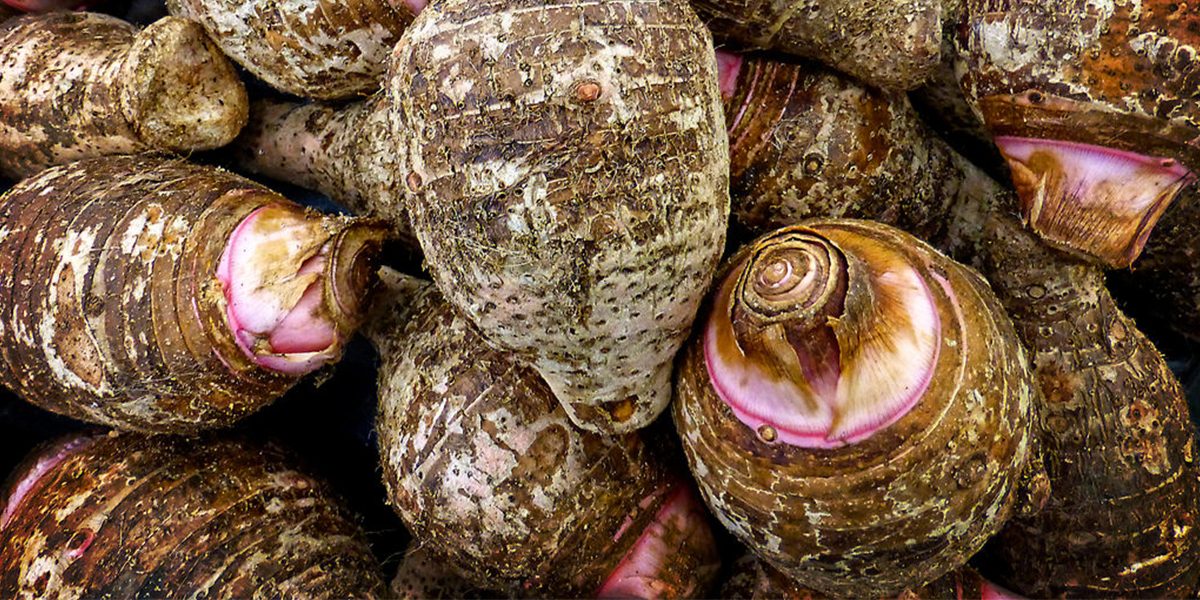
Often eaten with just your fingers, poi is described as one- two- or three-finger, depending on its thickness.
Below you’ll find an easy-to-follow recipe for “two finger poi.”
Traditionally, Hawaiians cooked the starchy, potato-like taro root for several hours in an imu. It was then pounded on large flat boards called papa ku’i’ai, using heavy stones called pohaku ku’i’ai. The taro was pounded into a smooth, sticky paste known as pa’i’ai (basically poi without added water) and stored in air tight ti leaf bundles. Poi was created by slowly adding water to the pa’i’ai, then mixed and kneaded to the perfect consistency. It is sometimes left to ferment, giving it a unique and slightly sour taste.
Here is a simple recipe for one of my favorite Hawaiian dishes – poi.
POI RECIPE
Materials & Equipment:
- vegetable brush
- 2-quart pot
- food processor
- medium-sized silicone or stainless steel mixing bowl
Ingredients:
- 1 or 2 taro roots
- water
Directions:
- Use a vegetable brush to scrub the taro root under cold, running water. Do not peel.
- In a large pot, cover taro with cold water and bring to a boil. Reduce heat to simmer and cook until taro can be pierced easily with a fork. Drain and rinse with cold water.
- Peel the cooked taro and cut into small pieces. Using 2 cups at a time, put the cooked taro into a food processor bowl.
- Add a tablespoon of water and process until smooth. The consistency should be sticky and thick enough to stick to one finger. (Adding more water will produce “three finger poi”.)
- Rinse a non-reactive bowl (typically made of silicone or stainless steel) with cold water and transfer the mixture to the bowl. Slowly pour a thin layer of cool water on top of the poi and cover the bowl with a clean kitchen towel.
- Allow the mixture to sit at a cool room temperature for 2-4 days. (optional, this step allows the poi to ferment and become sour)

Am I correct to understand that I need to leave poi to sit for several days before eating?
Hi Dana – thanks for your question! While it does help to make the poi “sour”, that step in the process is not necessary. I will revise the recipe to reflect this note.
Tried making poi.turned out terrible. I left it to ferment for 3 days. Tasted alcoholic had the strong smell of sourdough. Should i leave to ferment for longer for the bacteria to brwak down the alcohol similar to how they make vinegar?
Hi Dean – there could be other factors that lead to your result (temperature, humidity, etc.) It is not necessary to let it ferment so you might try eating the poi fresh rather than allowing it to sour. Fresh poi is absolutely delicious, especially with salty proteins! Please let me know how it turns out!
I think it may have been more of a shock to my system eating a more mature batch of poi. There one or two days that were humid. I think my mistake was to not stir it before trying it. I ate the same batch the next day after i gave it a good stir. Subsequent batches turned out good and I believe improved my digestion.
Did not taste alcoholic the next day i tried it. . I probably mistook it for the taste of the acids (lactic, formic, acetic etc). Was more of a shock to the system especially since I do not drink alcohol for religious reasons, so I am very wary of it in foods and drinks.
I’m happy to hear it turned out good, especially once you stirred it. Thanks for following up.
When making poi, it is essential to remove as much of the cortex as possible (known as ‘ilikana). The cortex is the layer of edible flesh that has converted from starches to sugars and can feed other types of bacteria and fungi, causing the poi to rapidly ferment and/or spoil (in your case, seems some type of yeast produced alcohol). You can eat the ‘ilikana as is or feed it to your plants (especially other taro plants).
When making pa’i ‘ai (the state of pounded kalo before it is mixed with water to make poi) and poi, it is important to use primarily the cooked starches of the tuber. This will allow the correct microbiology, and therefore, the right type of fermentation, to occur.
If you look up MANA AI or DANIEL ANTHONY on YouTube, he goes over the process in detail.
I am a bit confused on fermentation. The taro root is cooked, so all bacteria are dead (it is aseptic), so it seems that a starter culture would be needed to added to the cooked taro to initiate proper fermentation and not rotting. Maybe traditional methods of making poi, the pounding on large stones, wrapping on leaves, etc provided access to the correct bacteria and/or fungi?
I did a bit more research just now, and found a paper where the authors tried to determine the bacteria in poi.
” Lactic acid producing microorganisms from poi and the biological properties of one lactic acid bacteria are studied in this work. Based on phenotypical analysis, five bacterial strains isolated from fresh poi are identified as Lactobacillus acidophilus, Lactobacillus delbrueckii, Lactococcus lactis lactis, Leuconostoc citreum and Leuconostoc lactis individually. The gas-producing bacterial strain first identified as Lactobacillus acidophilus is finally identified as Weissella confusa by combining the results of phenotypical analysis and genotypical analysis. ”
this leads me to believe that maybe we, on the mainland, can take cool, fresh cooked taro and add some yogurt with active cultures or yogurt starter culture? Yogurt needs to ferment at a warm temp, which matches what occurs in Hawaii without A/C, when the poi is kept out to ferment. On the mainland I might need to control the temp of the fermenting poi, at least in the winter.
..just a mainlander that enjoys Poi!
I was raised in Hawaii but I now live in Washington State. I tried to make poi like this but it didn’t work. It never really got to a poi consistency. It was more like a startchy patato mash. I got these very large Taro roots from a Ranch 99 Asian market. Do you need a specific type of Taro?
Aloha e Ron, mahalo for your comment. Your results sound similar to what happens when trying to reheat frozen poi in a bag – when you reheat the poi and stir it, it looks a little chunky or gritty. You need to continue heating it more so that when you start to mash it with a fork it’s much more smooth in texture. Only then can you start slowly adding cold water to the mix so that it retains the consistency we all know and love! I hope this helps.
My husband and I prefer fresh poi that I make in large batches , but sometimes we don’t eat it fast enough. If it ferments without the water on top, is it still good to eat? (there was no sign of mold, etc)
Can this be made without a food processor?
Use a blender, just as good.
How long does the poi stay good? Does it need to be refrigerated after the 3 days?
I am after the same answer, i am on my third day of fermenting Poi and i want to know if i should put it in the fridge now.
Thank you!.
I want to make this for my students. We teach a unit on Hawaii and I thought it would be fun for them to try. How much will this make? I have 60 students to make this for.
Hi Heather. I just came across your recipe for making poi. My local supermarket also sells taro. I’m Hawaii-born but now live in northern California. I have loved poi all my life. I’ve eaten it since I was a child and miss it terribly. You might say I get cravings for it. I want to try making it so I can have it whenever I want. One question: when you make it in the food processor, is it better that the cooked taro is warm or should it be at room temperature?
Thank you for sharing the recipe! I just finished making this recipe and I am very excited. But I am a bit worried about the fermentation process. Might the taro mixture get moldy after a while because there was no strict sterilization process in this recipe (e.g., boil or sanitize all of the tools used in this recipe)? I have never made poi so I am curious and do not want this delicious dish to be spoiled. Thank you.
So I just got done boiling and now it’s sitting in the food processor. Just curious how long is poi good for? Also when doing a thin layer of water is it just some water in the bottom of the bowl of is it enough to cover/submerge the poi? Mahalo
The water just floats on top like when you store bagged poi.
Heather, I’m trying this for the first time, and both the root that was already peeled. Will this affect the cooking process of it?
Aloha Sistah! I’ve been making poi mainland style like dis fo’ plenty years now and get couple tricks fo’ you. Aftah you do da food processor or blender, pour ‘um into one wood or glass bowl (like pyrex kine so no break). Den put saran wrap ovah till da buggah get room temperature, maybe like 6 hours. Dis quickens da fermentation process so no need wait 2-4 days. Den remove da saran wrap an put watah on top so no make layer of skin, den put da saran wrap back an can store in da fridge li’dat fo’ like 5 days. Or can put ‘um in ziplock or food saver kine and throw ‘um in da freezer fo’ up to 6 months. Comes out ono!
Mahalo for the tips!
What do you use to strain the bugga? cheesecloth or what? maybe that’s why it wasn’t cramy smooth? what you tink?